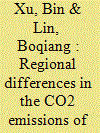| Srl | Item |
| 1 |
ID:
150789


|
|
|
|
|
| Summary/Abstract |
This study estimates output and substitution elasticities of renewable energy and nonrenewable energy for the Economic Community of West African States (ECOWAS) and discusses implications for expanding the former. The results show that nonrenewable energy promises greater benefits for ECOWAS economic transition, with output elasticities averaging between 0.052–0.579 and −0.055 to 0.223 for nonrenewable energy and renewable energy respectively. Overall estimated technological progress is low (−0.5% to 2.6%); the bulk coming from input efficiency. Substitution elasticities (0.02–0.94) suggest potential for switching towards renewable energy. Notwithstanding, scale, economics and sitting problems inherent in renewable power generation challenge the opportunities for energy substitution. A sustainable policy solution, therefore, appears to be one favoring scaled and efficient electricity generation from fossil energy in the short-run with a gradual switch towards renewable power in the long-run. In general, the applied model provides insights that energy efficiency enhances sustainable growth by propelling technological advancement especially when technical change is scale-biased and factor-augmenting. The study also provides insights that impacts of exogenous shocks to inputs are temporary, and hence, do not jeopardize efforts aimed at scaling output through increased and efficient use of labor, capital and energy; especially nonrenewable energy.
|
|
|
|
|
|
|
|
|
|
|
|
|
|
|
|
| 2 |
ID:
150391


|
|
|
|
|
| Summary/Abstract |
Identifying the key influencing factors of CO2 emissions in China's iron and steel industry is vital for mitigating its emissions and formulating effective environmental protection measures. Most of the existing researches utilized time series data to investigate the driving factors of the industry's CO2 emission at the national level, but regional differences have not been given appropriate attention. This paper adopts provincial panel data from 2000 to 2013 and panel data models to examine the key driving forces of CO2 emissions at the regional levels in China. The results show that industrialization dominates the industry's CO2 emissions, but its effect varies across regions. The impact of energy efficiency on CO2 emissions in the eastern region is greater than in the central and western regions because of a huge difference in R&D investment. The influence of urbanization has significant regional differences due to the heterogeneity in human capital accumulation and real estate development. Energy structure has large potential to mitigate CO2 emissions on account of increased R&D investment in energy-saving technology and expanded clean energy use. Hence, in order to effectively achieve emission reduction, local governments should consider all these factors as well as regional heterogeneity in formulating appropriate mitigation policies.
|
|
|
|
|
|
|
|
|
|
|
|
|
|
|
|